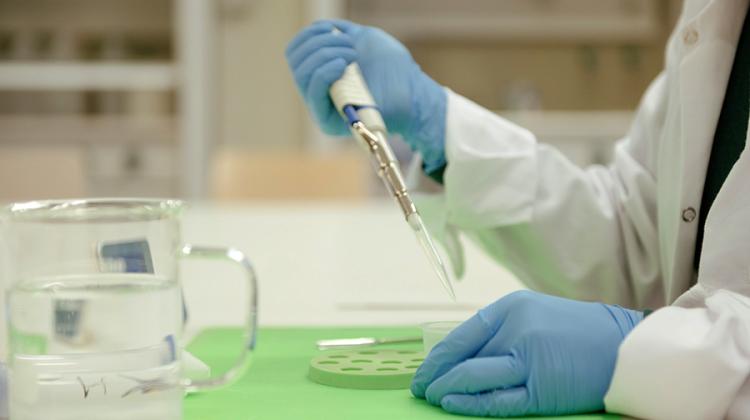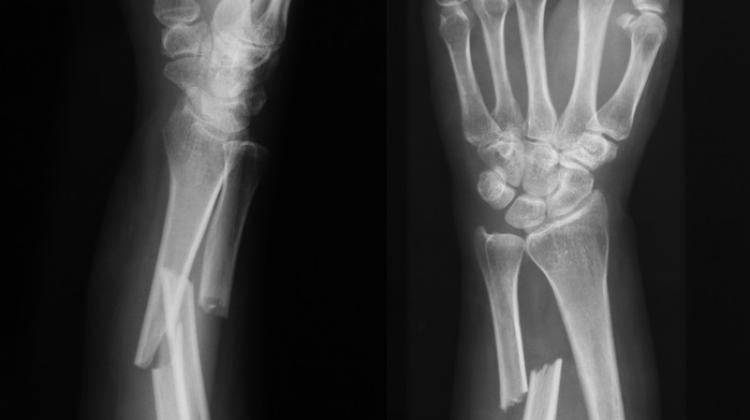Polish invention could revolutionise treatment of osteoporosis
Researchers from the Faculty of Chemistry of the Jagiellonian University have designed a material that could not only help refill bone cavities, but also serve as a carrier for osteoporosis medication.
The inventors emphasise that the word 'precise' is extremely important in the context of osteoporosis drugs, because these agents have strong and very troublesome side effects. The material developed by a team led by Professor Maria Nowakowska means they can be delivered to diseased areas, reducing the need to rely on systemic drug administration, which has been practiced so far.
Scaffolding for bone-forming cells
According to a Jagiellonian University press release, the new material has the form of a hydrogel. It is injected into cavities, where it hardens through the process of chemical crosslinking.
Thanks to its structure and composition, the hydrogel permanently fuses to bone tissue and serves as scaffolding which allows new tissue to naturally form and fill cavities
Dr. Joanna Lewandowska-Łańcucka, co-author of the invention, said: “The components used in our hydrogel imitate the natural composition of bone tissue.
“It contains collagen, hyaluronic acid and chitosan, a polysaccharide with confirmed antibacterial, anti-inflammatory and analgesic properties. Moreover, it also contains a key inorganic component: silica particles decorated with hydroxyapatite, which play a number of key roles in the designed therapy.”
She explained that after the hydrogel is injected, its components are bound with covalent bonds, which allows it to maintain its functionality, because it does not undergo uncontrolled degradation.
She said: “The hydroxyapatite used in the hydrogel is actually present in living organisms as the main inorganic building material of bone tissue, affecting its durability. It has the same purpose in our newly designed material.
“The mineral increases the density of the substance, which easily adheres to bone tissue after injection and serves as scaffolding for osteoblasts (bone-forming cells - ed. PAP) that rebuild the bone.”
Targeting a spot
This, according to Dr. Lewandowska-Łańcucka, is just a small part of the innovation. The real breakthrough is the hydrogel's ability to bind sodium alendronate, a popular osteoporosis medication, with the hydrogel. This results in a multifunctional material with therapeutic applications.
Because of this, “doctors will be able to inject it precisely where it is needed, after which it will be slowly released into the organism,” said Dr Adriana Gilarska, who worked on the hydrogel within the framework of her PhD thesis.
In addition, the specific chemical composition of the hydrogel allows the drug to be delivered to a specific place, i.e. in the vicinity of diseased tissues. This has two great advantages: firstly, the drug can be administered in higher doses, which increases the effectiveness of therapy, and secondly, bypassing other systems of our body eliminates many side effects that are common in current models of therapy.
Currently alendronate sodium is administered orally, which makes it systemic. The drug itself, while quite effective, has a number of side effects. For this reason, it cannot be administered orally in high doses, so only low concentrations are achieved in the diseased areas, which reduces the effectiveness of therapy, making the treatment process long and not always with satisfactory results.
New methods of treating osteoporosis has been to find a way for administering medication directly where it is needed. If, in addition, the drug was released gradually, it would further increase the effectiveness of the therapy.
The material designed by JU researchers fits that model of action. The invention is protected by Polish and international patents.
A material for rheumatologists, orthopaedists, neurologists and dentists
The researchers have already tested their material on mice, with promising results. The tests have proven the hydrogel's biocompatibility in vivo, the lack of any toxic effects and that natural angiogenetic processes (i.e. emergence of capillaries) occur in places where the hydrogel was administered. According to the inventors, this points to the possibility of using the material as scaffolding for bone tissue.
Another advantage is that the hydrogel itself degrades slowly, in a controlled way. At the end of the 60-day experiment, traces of hydrogel were still visible in places where it was injected. Further, in vitro studies have shown that sodium alendronate in the hydrogel is released into the organism gradually, increasing its effectiveness.
Dr Gabriela Konopka-Cupiał, Director of the JU Centre for Technology Transfer CITTRU said: “The first tests using cell lines and animal models show promising results.
“As of now, we're planning to use the hydrogel in designing therapies for small bone cavities, mainly resulting from osteoporosis, but also those caused by injuries or surgery. The newly invented material should be of great interest to rheumatologists, orthopaedists, neurologists and dentists.”
The research team is now looking for opportunities to work with investors that would fund further development of the invention, including final toxicology tests, testing on animals larger than mice, and human clinical trials. It will also be necessary to determine the optimal concentrations of sodium alendronate to obtain the best therapeutic results.
The authors also continue to work on further modifications of the hydrogel structure to increase the management possibilities of future osteoporosis treatment plans. For example: certain modifications of the silica used in the production of the material allow to bind several times more drugs and slow down the drug release process, which extends the time of its action.
Dr. Lewandowska-Łańcucka said: “This means that in the future, doctors will be able to adapt both the strength and length of the treatment to specific patients, virtually eliminating all side effects of systemic drug administration.”
(PAP)
PAP - Science in Poland, Katarzyna Czechowicz
kap/ agt/ kap/
tr. RL
Przed dodaniem komentarza prosimy o zapoznanie z Regulaminem forum serwisu Nauka w Polsce.

















